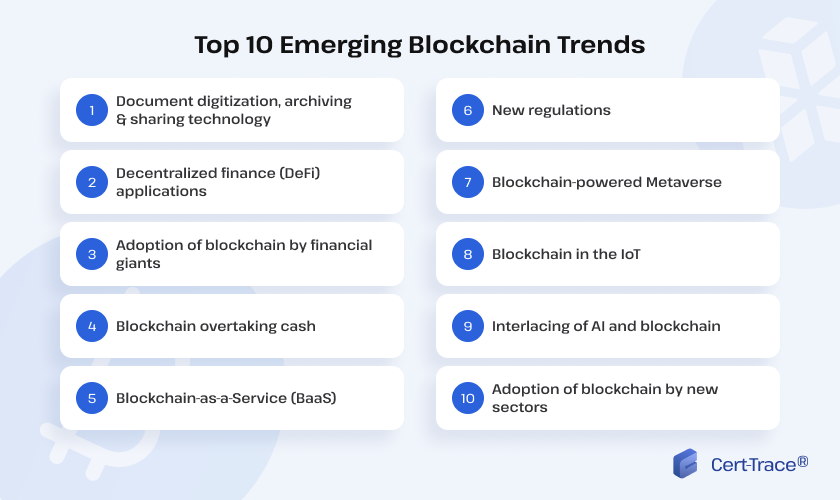Blockchain is a world where to stand still means to be left behind, so it’s always crucial to not just be on top of the latest blockchain trends but ahead of them.
With that in mind, we’ve created this list of the top 10 emerging blockchain trends to watch in 2024-2025, so you can see what’s coming down the line and work out how to make the most of it.

The top 10 emerging blockchain trends
Here’s everything you need to know about what trends to look out for in blockchain over the next couple of years.
1. Blockchain-powered document digitization, archiving & sharing technology
One of the most exciting blockchain trends that’s emerging is how it can be used for document storage and document digitization. This is such a crucial trend because blockchain security features mean that it’s perfectly suited to document archiving, offering immutability and accountability so that businesses can have confidence that their files are safe and secure.
This means that it could be used in healthcare to store confidential patient records, or for storing or sharing financial or legal documents, with the decentralization of blockchain meaning that it is almost impossible to hack into this data. This is because it is broken up into chunks that are scattered across the network, so hacking into one node would never give you access to a whole file, making it much more secure than traditional storage methods.
2. The rise of decentralized finance (DeFi) applications
Powered by the blockchain algorithm, DeFi is a decentralized ledger that records transactions and offers a real alternative to traditional finance, eliminating financial bureaucracy and strict regulations while at the same time offering security and opening up finance across international borders and opening up opportunities for those in developing countries without the traditional banking structures in place.
There’s plenty of growing DeFi technologies like GameFi (finance within blockchain games), FanFi (for fanbase management and revenue generation), MediaFi (multimedia financial management) and SciFi (finance for scientific researchers) which are starting to have a huge impact in their sectors and this list is growing.
3. More adoption of blockchain by financial giants
In many ways, it’s hardly a surprise that huge global organizations like JPMorgan Chase, BlackRock and Goldman Sachs are leading the way when it comes to exploring the opportunities for them in using blockchain technology.
They know that digital assets and transactions are the future and that tokenization can transform their sector, making them more secure and efficient through the use of smart contracts. So they’re plowing billions into blockchain services, creating a new financial landscape that has the potential to transform the way everyone in the world uses their money.
4. Blockchain overtaking cash
Another lasting impact of the pandemic was to push cash further into the background of global money usage. The number of cash machines on high streets has declined for years and it’s hard to see this trend reversing.
So we’re likely to see blockchain moving more and more into this area of public life, but while you might not expect to pay with Bitcoin at an ice cream van anytime very soon (look out for this in upcoming crypto trends lists in years to come though), it is already moving into a major area where cash still dominates – its use as a monetary anchor. This is where Central Bank Digital Currencies are starting to have more and more influence.
5. The rise and rise of Blockchain-as-a-Service (BaaS)
Fortune Business Insights says that the global blockchain-as-a-service market is set to reach $24,94 billion by 2027 and as blockchain usage becomes more and more mainstream, there is clearly going to be a rise in the need for services that make this adoption more straightforward. BaaS makes it easier for small businesses to integrate blockchain into their operations without expertise or expense of starting from scratch.
So it’s no surprise that Microsoft and Amazon are amongst the big names creating BaaS tools to make sure they are at the heart of this rise of usage in digital products and services related to blockchain trends.
6. New regulations to come into place
Blockchain might have started out as a financial wild west, but the law is coming to town ready to make it safer for regular folk. This is an inevitable phase of its wider adoption and we are already seeing the UK, the EU and USA all starting to draft and introduce regulations addressing the social and environmental risks of blockchain.
The private sector has so far done all the running in this area so it’s no surprise that the public sector is now joining in with a comprehensive regulatory framework, but there’s certainly challenges in agreeing and enforcing the rules over technology that is global in its nature and usage, particularly when it comes to keeping up with the latest crypto trends.
7. A blockchain-powered Metaverse?
It’s fair to say that so far the Metaverse has not had the transformative impact on our lives that Mark Zuckerberg had suggested it would with his famous (infamous?) launch video. But that doesn’t mean it still can’t achieve that, particularly with blockchain playing a huge role in how its virtual real estate, digital assets and games are managed and paid for.
Indeed, like blockchain trends more generally, the Metaverse is already starting to be looked at for how it can be used in industries as diverse as fashion, healthcare and even travel (why put up with long flights when you can visit somewhere virtually?) and all of these will rely on the newest blockchain technology to make them happen.
8. Blockchain in the Internet of Things
Another of the trends in blockchain that could have an impact on our everyday lives is the rise of its influence over the Internet of Things (IoT). We’ve already seen the IoT become more common in our homes, cars and workplaces, but blockchain has the potential to play a big part in making these transactions more secure and efficient through smart contracts in particular.
It can also help solve the issue of data silos and ensure that sectors like healthcare can more effectively (and safely) share data and research, without the delays and expense of utilizing intermediaries.
9. AI and blockchain coming together
Two of the biggest disruptive technologies of our age are blockchain and AI, so it’s inevitable that they will come together and the potential for their usage is enormous.
Of course, there’s risks involved, so careful consideration needs to be given to ethical, privacy and security concerns, but utilizing the opportunities that blockchain and AI could open up is an obvious next step.
10. New sectors adopting blockchain
And finally, we can expect more and more industries starting to realise how blockchain can help them to work smarter. From real estate to social media, it’s easy to see how the advantages of blockchain technology can be incorporated, starting off with its ability to be used in data storage.
So if you want to know more about how blockchain data archiving and more can help your business, why not get in touch with us at info@tracert.digital?
How useful was this post?
Click on a star to rate it!
Average rating 5 / 5. Vote count: 511
No votes so far! Be the first to rate this post.


